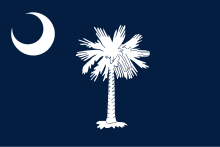1st South Carolina Volunteer Infantry Regiment (Colored)
| 1st Regiment South Carolina Volunteer Infantry (African Descent) | |
|---|---|
 South Carolina state flag | |
| Active | January 31, 1863, to February 8, 1864 |
| Country | United States |
| Allegiance | United States of America Union |
| Branch | Infantry |
| Equipment | Rifled muskets |
The First South Carolina Volunteers was a Union Army regiment during the American Civil War. It was composed of escaped slaves from South Carolina and Florida. It was one of the first black regiments in the Union Army. The 54th Massachusetts Volunteer Infantry, whose exploits are memorialized in the film Glory, was formed afterwards and drew from free Northern blacks.
Department of the South staff officer James D. Fessenden was heavily involved in efforts to recruit volunteers for the 1st South Carolina. Although it saw some combat, the regiment was not involved in any of the war's major battles. Its first commander was Thomas Wentworth Higginson who was—as were all the other officers—white. A proclamation by Confederate President Jefferson Davis had indicated that members of the regiment would not be treated as prisoners of war if taken in battle[citation needed]. The enlisted men would be auctioned off as slaves and the white officers were to be hanged. The threat was not carried out officially.
The regiment was a step in the evolution of Union thinking towards the escaped slaves who crossed their lines. Initially they were returned to their owners. Next they were considered contraband and used as laborers. Finally the legal fiction that they were property was abandoned and they were allowed to enlist in the Army, although in segregated units commanded by white officers. Harriet Tubman served with these men as a cook, nurse, spy, and scout. Susie King Taylor, whose husband and other relatives fought with the regiment, also served as a laundress and nurse for the men from August 1862 until mustering out on February 9, 1866.[1] As a hangover from the "contraband" days, black privates were paid $10 per month, the rate for laborers, rather than the $13 paid to white privates. The men served as the precedent for the over 170,000 "colored" troops who followed them into the Union Army.
Col. Higginson, a minister, author and abolitionist, documented the Gullah dialect spoken by the men and made a record of the spirituals that they sang. Captain Seth Rogers was regimental surgeon and wrote extensive war time letters. His nephew, Captain James Seth Rogers, previously of the 51st Massachusetts, was captain of Company B.[2]
The regiment was re-designated the 33rd United States Colored Infantry Regiment on February 8, 1864.
See also
References
- ^ Taylor, Susie King (1902). Reminiscences of my life in camp with the 33d United States Colored Troops late 1st S.C. Volunteers. Boston.
{{cite book}}: CS1 maint: location missing publisher (link) - ^ War-Time Letters From Seth Rogers, M.D. Surgeon of the First South Carolina Afterwards the Thirty-third U.S.C.T. 1862-1863. accessed May 3, 2016, at https://www.unf.edu/floridahistoryonline/Projects/Rogers/letters.html
Other sources
- Stephen V. Ash, Firebrand of Liberty: The Story of Two Black Regiments That Changed the Course of the Civil War (W. W. Norton & Company 2008).
- Higginson, Thomas Wentworth, Army Life in a Black Regiment, 1869.
